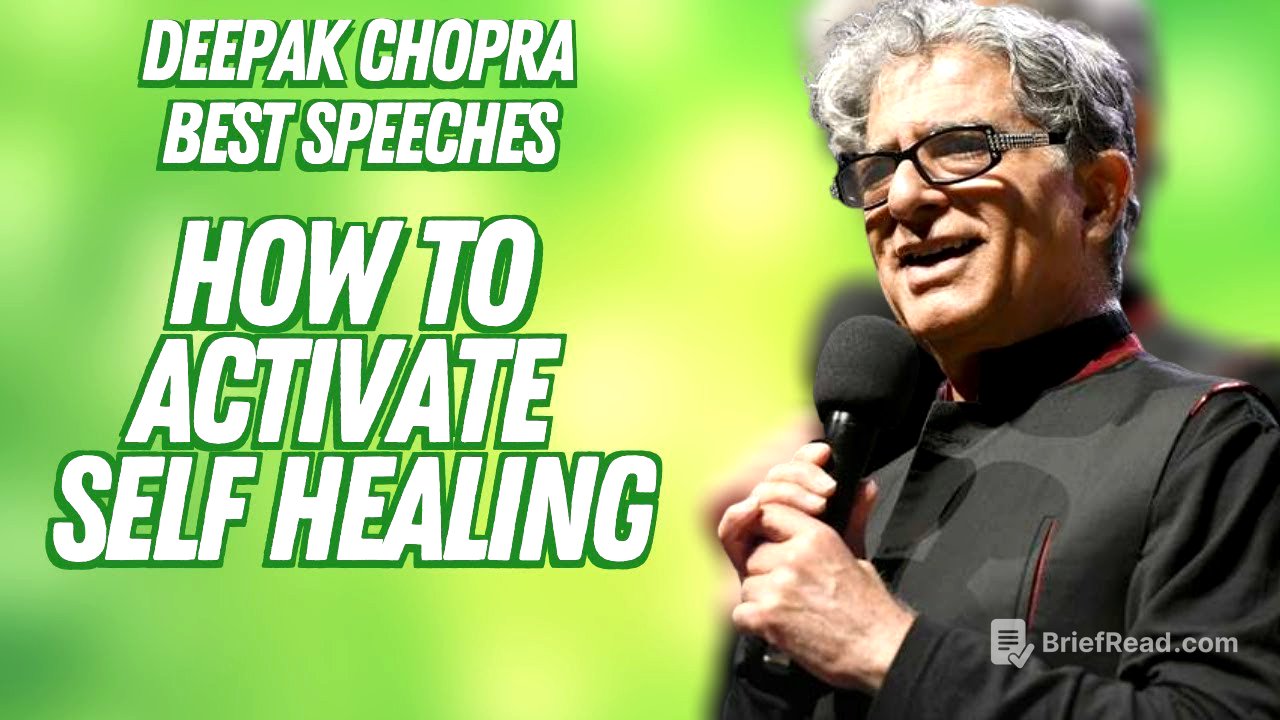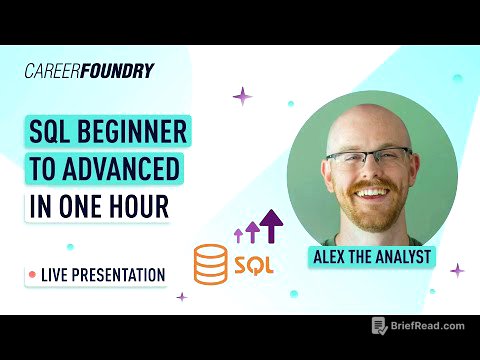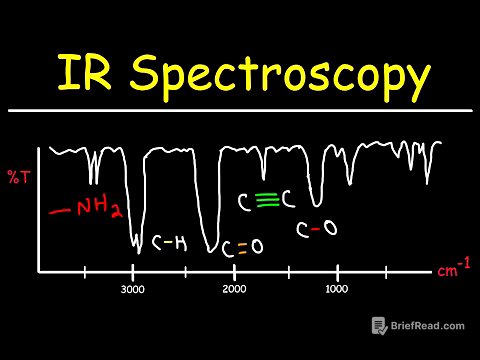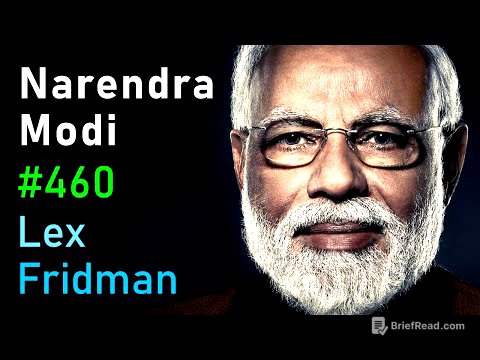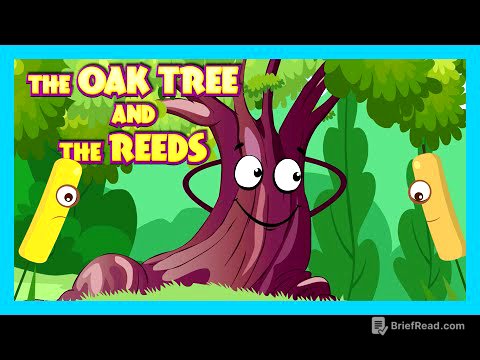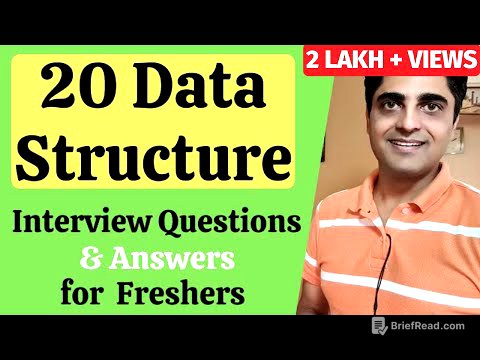TLDR;
Alright, so this video by Deepak Chopra talks about how we are all interconnected and part of the universe. He discusses the science behind this, including genetics, epigenetics, and the microbiome. He also talks about how stress interferes with our natural state of well-being and offers practical tips for restoring balance, like sleep, meditation, and healthy emotions. The key takeaway is that self-awareness is crucial for transforming our relationship with time and realizing our true potential.
- We are all interconnected and part of the universe.
- Stress interferes with our natural state of well-being.
- Self-awareness is key to transforming our relationship with time.
- Our true being is not in time.
- We can reinvent ourselves through self-awareness.
The Miracle of Conception and the Building Blocks of Life [0:00]
So, you know, it all starts with one sperm out of 200 million making it to the egg. At conception, you've got 23,000 genes, which are basically stretches of DNA that code for proteins. DNA, or deoxyribonucleic acid, uses four chemical bases: adenine (A), thymine (T), cytosine (C), and guanine (G). These four letters are the alphabet of life, used by everything from mosquitoes to bananas. These atoms come from burning stars, with hydrogen dating back to the Big Bang.
Morphogenesis, Differentiation, and the Illusion of Separation [3:28]
During the nine months of development, a single cell becomes a baby with 100 trillion cells through morphogenesis and differentiation. Morphogenesis is how form arises, and differentiation is how one cell becomes many specialized cells. It's important to remember that differentiation isn't separation; your liver isn't separate from your kidney, and so on. All these parts are one activity in a whole biological organism, which is itself one activity in the whole universe.
The Body as an Activity and the Concept of Self-Organization [6:17]
Separation is a misperception; there's only differentiation. The body doesn't have separate parts; it's all one activity. When we perceive this activity, we call it a "thing," but that's like mistaking a photo for the real person. Everything is constantly moving, a principle called self-organization. During those nine months, the developing baby goes through previous evolutionary forms, like reptile and amphibian. Interestingly, 65% of our genes are the same as a banana's.
The Microbiome: Our Second Genome [10:34]
When a baby is born, they inhale and swallow their mother's vaginal secretions, which inoculates them with the microbiome – the bacteria of our planet. This gives us 2.2 million additional genes. Even C-section babies get this inoculation through touch and cuddling. Technically, we're just a few human cells hanging onto a bacterial colony. These bacteria have 150 times more genes than our human genes, and they're in our gut, skin, and orifices, producing metabolites that keep us healthy through self-regulation.
Consciousness, Mind, and the Illusion of the Body [13:10]
The "self" that organizes all this is consciousness, which organizes itself as the mind and body, experiencing the universe. You are not your mind; your mind is an experience you're having. Your mind is your thoughts and emotions, your body is a collection of physical objects, and the universe is too. All are organized by you through recursion (repeating the past) and evolution (taking a new creative step). This interaction between the microbiome, genome, and epigenome is the basis of the book "Super Genes."
Epigenetics: How Experiences Shape Our Genes [15:18]
The epigenome is a layer of proteins made by the genome and microbiome in response to life experiences. Eating, breathing, the five senses, thoughts, emotions – every experience activates the genome to produce these proteins, which then regulate the genes. So, self-regulation is created by you, the self. The name you have is just an assumed identity; behind it is your innermost being, your soul, that has identified with a name, form, and experience. We are universal consciousness attached to these things.
The Body's Dynamic Nature and the Illusion of Permanence [17:45]
The body is a dynamic activity, constantly changing. It's not the same body you had yesterday or will have tomorrow. 98% of the atoms in your body recycle every year. With every breath, we share atoms with each other. Your stomach is new every five days, your skin every month, your liver every six weeks, and your skeleton every three months. DNA holds memories of millions of years, but the actual atoms come and go every six weeks. You are not your body; it's an activity of the universe happening in you.
Influences on the Body and the Importance of Wholeness [21:10]
This activity is influenced by sound, touch, sight, taste, smell, sleep, thoughts, emotions, and more. It's all one holistic activity. The words "holistic," "health," and "holy" are the same word. Healing is remembering who we are, wholeness is remembering what is sacred. We mess this up by feeling stressed and threatened. Stress interferes with the spontaneous manifestation of experience from the invisible domain of our spirit, soul, and consciousness.
The Impact of Stress and the Six Pillars of Well-being [22:31]
Stress leads to escaping through drugs, alcohol, eating disorders, and taking it out on others, ultimately leading to disease. This includes everything from skin eruptions to cardiovascular problems, all related to interfering with what's natural. To restore balance, start with the basics: sleep, meditation, stress management, movement, healthy emotions, and healthy nutrition (avoiding chemicals and processed foods).
Biological Rhythms and the Importance of Connecting with Nature [26:51]
We have biological rhythms tied to the Earth's spin (circadian), its orbit around the sun (seasonal), the moon's cycles (lunar), and tidal forces. Connecting with nature balances these rhythms. Anytime you're in contact with the earth, breathing fresh air, or looking at the stars, you're balancing your rhythms.
The Power of Sleep and Meditation [29:19]
Sleep is a spiritual experience. During sleep, you go from your physical body to your subtle body (mind, intellect, ego) and then to your soul. Your unconscious mind is very active during sleep, processing information, getting rid of stress, and enhancing immunity. Sleep solidifies learning, helps you think clearly, and balances hormones. Combining meditation with good sleep gets you in touch with your soul.
Scientific Studies on Meditation and Well-being [31:14]
Studies show that meditation lengthens telomeres, the extensions of your genes that help you live longer. One week of a retreat can increase the enzyme telomerase by 40%, reversing your age. Meditation and retreats impact disease-associated molecular phenotypes, the molecules produced by your genes. These activities can predict who will get sick and who will get healthy.
The Role of Genes and Epigenetics in Health [33:48]
Genes responsible for healing increase in activity, while those that make it more likely to get sick decrease. Only 5% of disease-related gene mutations guarantee the disease. This means that for 95% of chronic illnesses, we can change the expression of the genes and participate in changing the outcome. Epigenetics is all about this. How you live your life, including your thoughts, feelings, diet, and lifestyle, affects gene expression.
The Vagus Nerve and the Mind-Body Connection [36:41]
There's no difference between what's happening in your mind, consciousness, emotions, and body. The vagus nerve connects the brain to the body and influences heart rate, organs, and the microbiome. The bacteria in the microbiome also make chemicals that feed the brain and influence mood and cognition. Yoga stimulates this nerve, activating healing and self-regulation.
Gratitude, Biofields, and the Interconnectedness of All Things [38:11]
Practicing gratitude changes your body and brain. Studies show that gratitude reduces inflammatory markers in heart failure patients and activates the frontal cortex. Our bodies are like electrical batteries, and the universe has an electromagnetic field. The biofield, the energy from your body, corresponds to how you're feeling. Our biofields interfere with each other, regulating and monitoring each other. There's no separate self, body, or mind; we're all part of one body, the universe.
Energy Medicine, Brain Waves, and the Power of Consciousness [42:11]
Energy medicines like Reiki can be understood as biofield medicine. Within seconds of meditation, your brain and heart move into a healthy direction. Studies document these changes. Human thoughts can influence genes, even in other species. We have personal, transpersonal, collective, and trans-species consciousness. Ultimately, we are all expressions of one consciousness.
Higher States of Consciousness and the Nature of Time [45:03]
Higher states of consciousness include transcendence, joy, flow, feeling one with each other and the universe, and activating intuition. All religions are founded on higher consciousness, going beyond thought and experiencing oneness. Time is created when we separate; it's the ego's mind. The more stressed you are, the more you feel like you're running out of time. But our awareness is not in time; only our experiences are.
The Illusion of the Present and the Nature of Being [48:09]
You can't catch the present; as soon as you try, it's over. Our life is a dream, and we occasionally wake up enough to know we're dreaming. Turn your attention to who is listening; be aware of the listener. What you're experiencing is your being, a presence prior to thought and emotion. Without being, there's no experience. Being is not in time; it's who we are.
The Self and the Nature of Experience [51:11]
Our innermost being was never born and is not subject to death. What dies is experience: thoughts, emotions, perceptions, which are fluctuations of our own self. A thought is a movement of consciousness. The mind-body universe is constantly going on and off, and what's going on and off is you, the self. To wake up to the dream is to wake up to the presence that is always there.
Transforming the Body and the Science of Metabolomics [53:04]
When we look after ourselves with massage, meditation, yoga, and a good diet, we transform our body. This is the science of metabolomics, measuring all the metabolites, proteins, and inflammatory markers. Studies show that simple practices transform your body. Different yoga asanas have different self-regulatory mechanisms for physical and psychological well-being. Emotions act as immunomodulators, and nutrition is very important.
The Importance of Nutrition, Grounding, and the Healing System [54:51]
The closer our food is to the energy of the sun, the healthier it is. Colorful foods and Ayurvedic herbs regulate our genome. Grounding, or earthing, involves direct contact with the earth, which suffuses your body with negative ions that neutralize free radicals. This reduces inflammation, pain, and improves sleep, energy, and hormone balance. Our consciousness guides our biology through the brain, orchestrating self-regulation.
The Six Pillars Revisited and the Importance of Self-Awareness [1:01:04]
Revisit the six pillars: question your body as a thing, engage differently with time, make sleep a spiritual experience, practice meditation, be mindful of what you put in your body, and avoid toxins. Be adaptable and flexible, and cultivate a childlike innocence, full of wonder and curiosity. Experience love as the ultimate truth. The key is self-awareness.
The Burden of the Past and the Five Causes of Suffering [1:03:39]
Humans suffer because they're burdened by the past and fear the future. Suffering comes from not knowing the true nature of reality. Our perceptual experience is shaped by the conditioned mind. We grasp and hold onto experiences that don't last. The five causes of suffering are: not knowing the true nature of reality, grasping onto experiences, fear of impermanence, identification with a false self, and fear of death.
The Illusion of "I" and the Nature of Consciousness [1:08:22]
We tell ourselves a story based on a false understanding of who we are. We think we are the body-mind, but the body-mind is an object of experience. When asked where you are, you say "I'm here," but there's no "I" to be found inside your body. "I" is the one experiencing form, thoughts, and the body. "I" is not in time. Our true essence is spirit, which has no form. Faith is not belief; it's knowing.
The Power of Intention and the Path to Self-Discovery [1:11:12]
"I" is the source of intention and reflection, the source of every experience. Without "I," there is no experience. All our problems come from not knowing who we are. We are infinite being having a finite experience. We are non-local beings having a local experience. Living in this place brings practical values: possibilities, creativity, intention, and synchronicity.
The Source of Mind and the True Meaning of Yoga [1:13:28]
At this level, there are solutions to perceived problems. You can't solve a problem created by the mind with the mind. Get to the source of mind, which is the source of thought and perception. An object of experience cannot be the source of experience. Consciousness cannot be found in an object in consciousness; it can only be found by going back to the source. This is the true meaning of yoga: going back to your source. When we find ourselves, we discover all the secrets of the universe.
The Journey of Self-Discovery and the Importance of Imagination [1:15:36]
We took a journey starting with how we came into name and form, but it's our destiny to assume infinite names and forms. Don't get stuck on one name or form. Imagination is more important than knowledge because it comes from our consciousness. The sequence is: awareness, thought, feeling, perception, reality. "I am, therefore I think," because without being, there's no thought or feeling.
